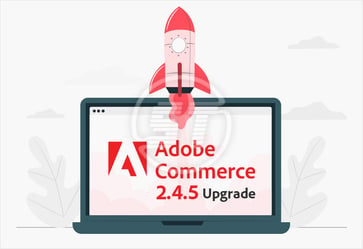Ecommerce is the future of every business, and business owners are aware of this evident fact. That’s why every business has either already started their online operation or they are planning to launch alluring online stores.
As we know, change is the only constant. If you don’t change, your existence will be obsoleted soon. Thus, to survive in the modern market with your traditional business and to withstand new start-ups, you need to think technically. Yes, technology can be your saviour.
There is a saying, “You can’t wait for customers to come to you. You have to figure out where they are, go there and bring them back to your store.”
Do you know, where modern customers are? They hardly visit a brick-and-mortar store, rather they love doing online shopping. And this is the place where technology can find customers for you and help soar your business again.
When we are discussing ecommerce, which name comes first to your mind?
Adobe Commerce or Magento, isn’t it? Adobe Commerce is a buzzword in ecommerce world. Apparently, it is made for ecommerce businesses. From single online stores to multi-vendor marketplaces, every business model is effectively handled by Adobe Commerce.
Now, Adobe Commerce has an in-house competition and that is Adobe Experience Manager. That’s interesting! We shall find more about Adobe Experience Manager and the difference between these two platforms from the house of Adobe.
Adobe Commerce & Adobe Experience Manager
Adobe Commerce (formally Magento) is known to us. It is an open-source software, written in PHP. It is vendors’ favourite due to its flexibility, scalability, and whatnot. This platform allows merchants to create and run their ecommerce stores with full control over the front-end, backend, content, etc. It has ancillary features for every ecommerce store. For example, flexible cart system, easy installation, and integration of plugins, pocket-friendly, compatible with different payment gateways, and the list is unbounded.
Whilst Adobe Experience Manager (AEM) is a comprehensive content management system, which helps managing content and assets easily. This platform also assists vendors to set up their stores and manage them perfectly. Adobe Experience Manager is helpful in building websites, mobile apps, and forms. The amazing features Adobe Experience Manager has been compatibility with important marketing tools, use of ready-made components, automation of content tag and metadata designation, swift integration with digital asset management system, well-organized content management workflow, and many more.
Difference between Adobe Commerce and Adobe Experience Manager
| Adobe Commerce | Adobe Experience Manager | |
|---|---|---|
| Who can use it? | Adobe Commerce allows any size of organization to create and manage ecommerce stores and offer personalized experience with customer segmentation, content staging, visual merchandising, etc. | Adobe Experience Manager is a content management system for enterprises, which helps business owners to create, manage and optimize customer experience across all the channels. |
| Features | Adobe Commerce offers:
| Adobe Experience Manager offers:
|
| Ease of use | It has all the modern tools that make ecommerce store creation easy and swift | It offers inline editing and drag and drop functionality, Moreover, content publishing can be done by one authorized user across the channels. |
| Personalization | Offers personalized customer experience using analytics data | Provides amazing, personalized experience and easily integrates with Adobe Target and Adobe Analytics to help in personalization |
| Adobe integration | Can integrate with every native Adobe product such as Analytics, Target, Experience Manager, Creative Cloud, etc. | Adobe Cloud tools and every other native Adobe product |
| Multi-channel Commerce | Adobe Commerce can manage multiple sales channels and brands from a single hub. It also provides a multi-vendor marketplace business model | It supports multi-channel content management |
| AI Powered Commerce | Offers actionable data analysis, catalogue updates, product recommendation, site content creation, customer targeting, etc. | It supports AI to bring more innovative features, for example, Adobe Experience Manager can now automatically tag images. |
| Headless capabilities | With the headless capabilities of Adobe Commerce, you can quickly incorporate modern technologies to scale the ecommerce business | It also offers headless capabilities, where you can control the content presentation with your own codes in any programming language. |
| Tools that can integrate |
|
|
Advantages of Adobe Commerce
Adobe Commerce is famous due to the myriad qualities it has, for example:
- It is extremely SEO-friendly.
- Open-source and highly flexible.
- Supports multiple languages and currencies.
- Enormous community support.
- Scalable with a comprehensive set of tools for ecommerce store.
- Out-of-box integrations.
- Multichannel support.
- Advanced catalogue management.
Advantages of Adobe Experience Manager
- Perfect for handling colossal data.
- Creative Cloud integration for efficient digital asset management.
- Users can leverage the smart search facility.
- Streamlined task management system.
- Multi-site management.
- Organized folder structure.
- Quick updates and publishing. Marketers can do it without relying on anyone.
- Easy authorized workflow for the marketing team.
- Provides reusable components to create content.
The benefit of integrating Adobe Commerce and Adobe Experience Manager together
Both are exceptional platforms that help vendors to add more quality and functionality to their ecommerce business. Adobe Commerce and Adobe Experience Manager can be paired together to deliver out-of-box experience.
Let’s see how the integration of Adobe Experience Manager and Adobe Commerce works.
Being fast with accuracy is the key to ecommerce success. Marketers who use Adobe Commerce must depend on a defined development process to deploy content. While Adobe Experience Manager makes the content development and deployment swift, probably known by Adobe Commerce developers.
And the integration of Adobe Experience Manager and Adobe Commerce gives the freedom to manage the entire workflow. You will be able to control content deployment at your ease. The development process will no longer influence content publishing. Moreover, marketing teams can perform A/B testing if required and manage content accordingly across the platforms.
Adobe Experience Manager assists in shaping your product listing page and product detail page and the content will be published via a headless server (such as Amazon S3) within no time. It makes the marketing team's work easier because they don't have to rely on other teams for content management.
Adobe Commerce and Adobe Experience Manager integration happen smoothly using Commerce Integration Framework (CIF). The CIF uses Adobe Commerce's GraphQL API and enables Adobe Experience Manager to directly communicate with commerce elements. These elements allow you to create rich content, which you will be able to re-use across Adobe Experience Manager's applications even if you use the same Adobe Commerce core.
Adobe Commerce extensions that support PWA with GraphQL can be used with Adobe Experience Manager as well. It implies, that if you are installing an Adobe Commerce extension with GraphQL support, you can integrate that extension with Adobe Experience Manager elements without any problem. This way, you can improve the overall efficiency of the system without having to install new extensions.
Adobe Experience Manager along with Adobe Commerce provides you with the freedom of creating user experience designs, which personalize the experience to drive conversion.
By utilizing the power of Adobe Experience Manager and Adobe Commerce, any ecommerce business can reduce the cost of infrastructure (because using a smaller number of tools), simplify the development process, and streamline operating models. Hire Magento developers to enable any kind of customization.
Integration of both Adobe Commerce and Adobe Experience Manager improves the consistency of user experience, which aids businesses in growing at a faster pace.
The Adobe Commerce and Adobe Experience Manager are not dependent on each other but once integrated using CIF, they allow the data flow between the applications in real-time and thus, improves the system’s efficiency.
Wrapping up
Both Adobe Commerce and Adobe Experience Manager offer exceptional solutions for ecommerce businesses. You have your unique business needs, contemplate them with the above comparison and decide which platform you wish to choose for your ecommerce store. Or the integration of Adobe Commerce and Adobe Experience Manager can be an intelligent option as well.
Focus on competition but don’t solely depend on their moves, try to pay attention to customers and be pioneering. Your business will soar higher if you will succeed in improving customer experience. Therefore, either choose Adobe Commerce or Adobe Experience Manager, the idea to pick these technologies must be providing top-notch quality customer experience.
Skynet Technologies is an official Adobe Bronze Solution Partner.
As a specialized Magento development company, we provide Adobe Commerce solution architecture, UI/UX design, platform migration & upgrades, API / integrations, multi-vendor multi-channel marketplace, multi-tenant solution, performance optimization, Google core web vitals implementation, digital marketing, omnichannel strategy, Adobe Commerce store ADA compliance & security, product information management solution, and more.
Not limited to this, with a huge pool of experienced team of Adobe Experience Manager specialists at your disposal, innovate and create enterprise-level Adobe Experience Manager solutions and deliver tangible benefits to your business.
Get in touch with us at hello@skynettechnologies.com or submit the following request free quote form to know more about Adobe Commerce and Adobe Experience Manager development services.


